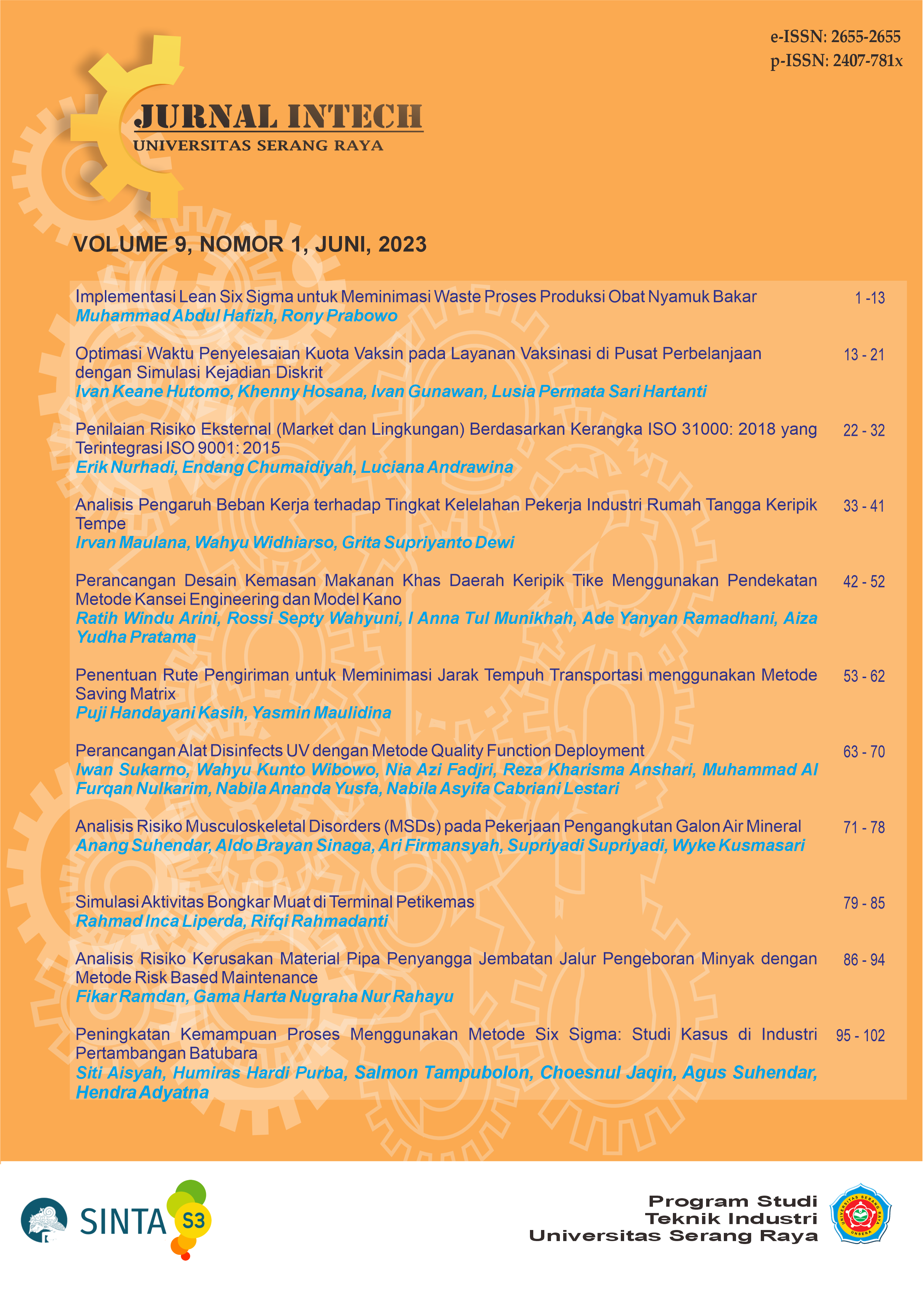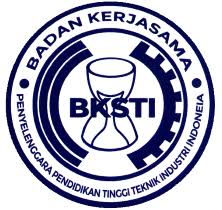Optimasi Waktu Penyelesaian Kuota Vaksin pada Layanan Vaksinasi di Pusat Perbelanjaan dengan Simulasi Kejadian Diskrit
DOI:
https://doi.org/10.30656/intech.v9i1.5045Keywords:
Antrean Vaksinasi, Simulasi Kejadian Diskrit, Vaksinasi Massal COVID-19Abstract
Pemerintah Indonesia berjuang mengatasi pandemi COVID-19 ini dengan memberikan vaksin gratis terhadap masyarakat guna menciptakan herd immunity. Tempat penyelenggaraan vaksin yang terbatas dan desakan untuk segera menyelesaikan target vaksinasi memunculkan ide untuk menjadikan pusat perbelanjaan sebagai tempat vaksinasi massal. Pusat perbelanjaan hanya dapat menyediakan waktu yang terbatas untuk menyelenggarakan layanan vaksin. Layanan vaksin harus selesai sebelum pusat perbelanjaan beroperasi agar tidak mengganggu pengunjung pusat perbelanjaan. Studi ini bertujuan menemukan konfigurasi sistem antrean yang optimal untuk menyeleÂsaikan kuota dosis vaksin yang diberikan pemerintah pada setiap penyeÂlenggaraan vaksinasi massal di pusat perbelanjaan. Studi ini dilakukan pada konfigurasi sistem antrean vaksinasi massal yang diselenggarakan di lobi Galaxy Mall 3 di Surabaya. Model simulasi kejadian diskrit dikembangkan untuk merepresentasikan sistem nyata dan mengevaluasi konfigurasi sistem antrean vaksinasi booster. Tiga usulan skenario perbaikan yang aplikatif telah diuji. Hasilnya, skenario 3 (kombinasi skenario 1 dan skenario 2) yakni mengÂgandakan kapasitas booth 4 dan mengurai penumpukan di ruang tunggu luar dengan meningkatkan ukuran kelompok peserta vaksin yang masuk dari 6 menjadi 9 merupakan strategi operasional yang paling efektif untuk meningÂkatkan performa sistem antrean. Waktu yang dibutuhkan untuk menyelesaikan 250 dosis vaksin turun sebesar 45% dari 2,5350 jam pada kondisi awal menjadi 1,3989 jam pada skenario 3.
Downloads
References
Aldila, D., Khoshnaw, S. H. A., Safitri, E., Anwar, Y. R., Bakry, A. R. Q., Samiadji, B. M., Anugerah, D. A., GH, M. F. A., Ayulani, I. D., & Salim, S. N. (2020). A mathematical study on the spread of COVID-19 considering social distancing and rapid assessment: The case of Jakarta, Indonesia. Chaos, Solitons & Fractals, 139, 110042. https://doi.org/10.1016/j.chaos.2020.110042
Asgary, A., Blue, H., Cronemberger, F., & Ni, M. (2022). Simulating a Hockey Hub COVID-19 Mass Vaccination Facility. Healthcare, 10(5), 843. https://doi.org/10.3390/healthcare10050843
Badan Pusat Statistik. (2022). Jumlah Penduduk Pertengahan Tahun (Ribu Jiwa), 2020-2022. Badan Pusat Statistik. https://www.bps.go.id/indicator/12/1975/1/jumlah-penduduk-pertengahan-tahun.html
Bhat, U. N. (2015). An Introduction to Queueing Theory (Vol. 36). Birkhäuser Boston. https://doi.org/10.1007/978-0-8176-8421-1
Brambilla, A., Mangili, S., Macchi, M., Trucco, P., Perego, A., & Capolongo, S. (2021). Covid-19 Massive Vaccination Center Layouts. A Modular and Scalable Model for Lombardy Region, Italy. Acta Bio Medica: Atenei Parmensis, 92(6), 1–11. https://doi.org/10.23750/abm.v92iS6.12229
Chenchula, S., Karunakaran, P., Sharma, S., & Chavan, M. (2022). Current evidence on efficacy of COVID-19 booster dose vaccination against the Omicron variant: A systematic review. Journal of Medical Virology, 94(7), 2969–2976. https://doi.org/https://doi.org/10.1002/jmv.27697
Drake, C. (2019). National Integration in Indonesia: Patterns and Policies. University of Hawaii Press. https://books.google.co.id/books?id=TVrGDwAAQBAJ
Frederiksen, L. S. F., Zhang, Y., Foged, C., & Thakur, A. (2020). The Long Road Toward COVID-19 Herd Immunity: Vaccine Platform Technologies and Mass Immunization Strategies. Frontiers in Immunology, 11, 1817. https://doi.org/10.3389/fimmu.2020.01817
Fun, W. H., Tan, E. H., Khalid, R., Sararaks, S., Tang, K. F., Ab Rahim, I., Md. Sharif, S., Jawahir, S., Sibert, R. M. Y., & Nawawi, M. K. M. (2022). Applying Discrete Event Simulation to Reduce Patient Wait Times and Crowding: The Case of a Specialist Outpatient Clinic with Dual Practice System. Healthcare, 10(2), 189. https://doi.org/10.3390/healthcare10020189
Green, L., & Yih, Y. (2016). Queueing Theory and Modeling*. In Handbook of Healthcare Delivery Systems (pp. 235–252). CRC Press. https://doi.org/10.1201/b10447-20
Hanly, M., Churches, T., Fitzgerald, O., Caterson, I., MacIntyre, C. R., & Jorm, L. (2022). Modelling vaccination capacity at mass vaccination hubs and general practice clinics: a simulation study. BMC Health Services Research, 22(1), 1–11. https://doi.org/10.1186/s12913-022-08447-8
Hupert, N., Mushlin, A. I., & Callahan, M. A. (2002). Modeling the Public Health Response to Bioterrorism: Using Discrete Event Simulation to Design Antibiotic Distribution Centers. Medical Decision Making, 22(1), 17–25. https://doi.org/10.1177/027298902237709
Kumar, P., Erturk, V. S., & Murillo-Arcila, M. (2021). A new fractional mathematical modelling of COVID-19 with the availability of vaccine. Results in Physics, 24, 104213. https://doi.org/10.1016/j.rinp.2021.104213
Monks, T., Currie, C. S. M., Onggo, B. S., Robinson, S., Kunc, M., & Taylor, S. J. E. (2019). Strengthening the reporting of empirical simulation studies: Introducing the STRESS guidelines. Journal of Simulation, 13(1), 55–67. https://doi.org/10.1080/17477778.2018.1442155
Saidani, M., Kim, H., & Kim, J. (2021). Designing optimal COVID-19 testing stations locally: A discrete event simulation model applied on a university campus. PLOS ONE, 16(6), e0253869. https://doi.org/10.1371/journal.pone.0253869
Sargent, R. G. (2010). Verification and validation of simulation models. Proceedings of the 2010 Winter Simulation Conference, 166–183. https://doi.org/10.1109/WSC.2010.5679166
Su, Z., McDonnell, D., Li, X., Bennett, B., Šegalo, S., Abbas, J., Cheshmehzangi, A., & Xiang, Y.-T. (2021). COVID-19 Vaccine Donations—Vaccine Empathy or Vaccine Diplomacy? A Narrative Literature Review. Vaccines, 9(9), 1024. https://doi.org/10.3390/vaccines9091024
Valeriano, C. M. C., Ilo, C. K. K., Illescas, M. K. A., Dahilig, J. A. V, & Estember, R. D. (2021). Queuing Theory: A Case Study in Analyzing the Vaccination Service in Quezon City. The International Conference on Industrial Engineering and Operations Management, 2521–2531. http://ieomsociety.org/proceedings/2021monterrey/439.pdf
Villaflores, J. A. J., Llegos, M. Z. A., Guna, U. K. L., Faminiano, M. A. F., Cruzado, L. D., Mendoza, K. R., & Reyes, J. E. A. (2021). Process Improvement of COVID-19 Vaccination System by utilizing Queuing Theory and ProModel Simulator on Vaccination Facilities in Metro Manila. The Second Asia Pacific International Conference on Industrial Engineering and Operations Management, 1, 2075–2085. http://ieomsociety.org/proceedings/2021indonesia/392.pdf
Wood, R. M., Moss, S. J., Murch, B. J., Davies, C., & Vasilakis, C. (2021). Improving COVID-19 vaccination centre operation through computer modelling and simulation. medRxiv, 1–21. https://www.medrxiv.org/content/10.1101/2021.03.24.21253517v1
Wood, R. M., Murch, B. J., Moss, S. J., Tyler, J. M. B., Thompson, A. L., & Vasilakis, C. (2021). Operational research for the safe and effective design of COVID-19 mass vaccination centres. Vaccine, 39(27), 3537–3540. https://doi.org/10.1016/j.vaccine.2021.05.024
World Health Organization. (2022). 14.9 million excess deaths associated with the COVID-19 pandemic in 2020 and 2021. World Health Organization. https://www.who.int/news/item/05-05-2022-14.9-million-excess-deaths-were-associated-with-the-covid-19-pandemic-in-2020-and-2021









.png)
.png)
.png)



.png)

.png)
